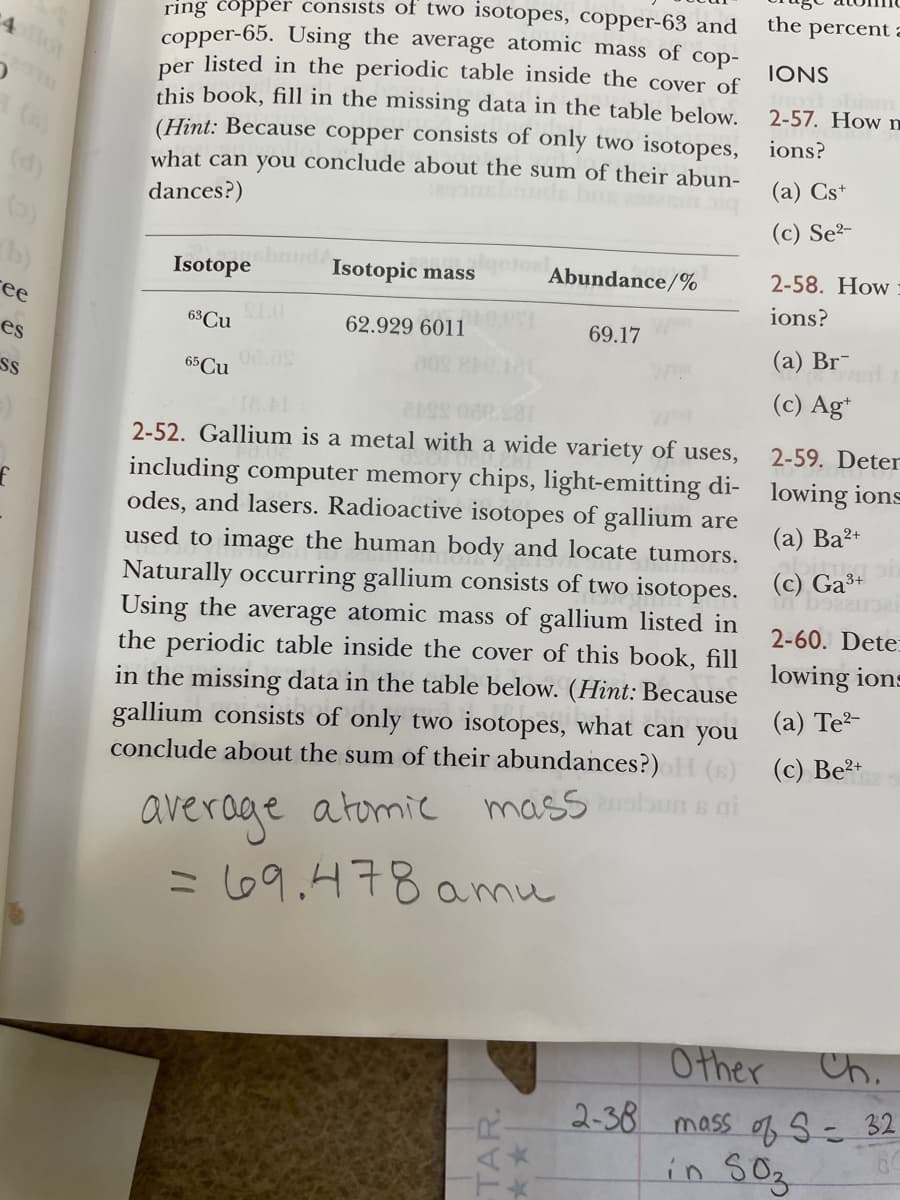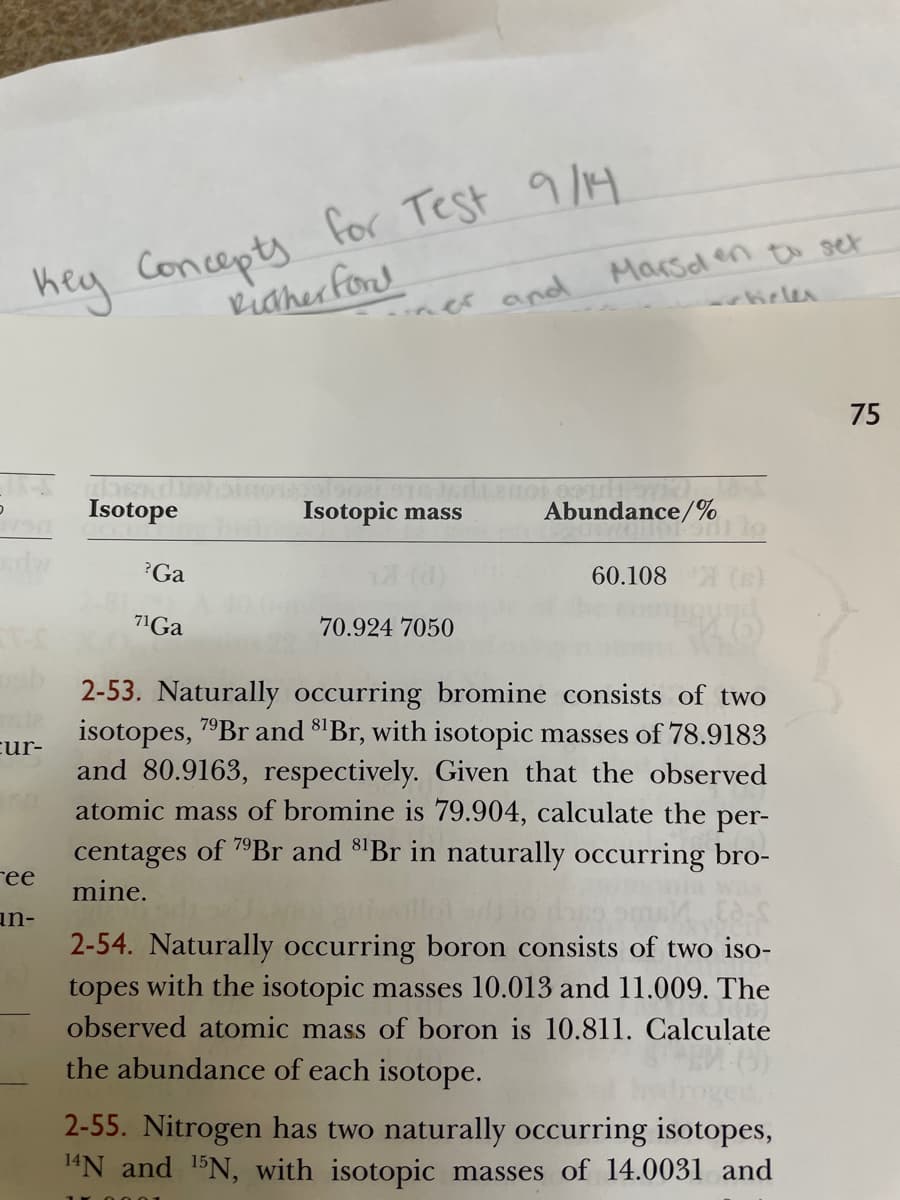2-52. Gallium is a metal with a wide variety of uses, including computer memory chips, light-emitting di- odes, and lasers. Radioactive isotopes of gallium are used to image the human body and locate tumors. Naturally occurring gallium consists of two isotopes. Using the average atomic mass of gallium listed in the periodic table inside the cover of this book, fill in the missing data in the table below. (Hint: Because gallium consists of only two isotopes, what can you conclude about the sum of their abundances?) H (6) 1
2-52. Gallium is a metal with a wide variety of uses, including computer memory chips, light-emitting di- odes, and lasers. Radioactive isotopes of gallium are used to image the human body and locate tumors. Naturally occurring gallium consists of two isotopes. Using the average atomic mass of gallium listed in the periodic table inside the cover of this book, fill in the missing data in the table below. (Hint: Because gallium consists of only two isotopes, what can you conclude about the sum of their abundances?) H (6) 1
Chemistry for Engineering Students
4th Edition
ISBN:9781337398909
Author:Lawrence S. Brown, Tom Holme
Publisher:Lawrence S. Brown, Tom Holme
Chapter2: Atoms And Molecules
Section: Chapter Questions
Problem 2.19PAE: 2.19 Naturally occurring uranium consists of two isotopes, whose masses and abundances are shown...
Related questions
Question
Problem 2-52 only; atomic mass is written on the problem in the first picture. Use correct sig figs

Transcribed Image Text:ring copper consists of two isotopes, copper-63 and
copper-65. Using the average atomic mass of cop-
listed in the periodic table inside the cover of
the percent a
4
IONS
per
this book, fill in the missing data in the table below.
(Hint: Because copper consists of only two isotopes, ions?
what can you conclude about the sum of their abun-
2-57. How
(d)
()
b)
(а) Cs*
dances?)
(c) Se²-
Isotopic mass
Abundance/%
2-58. How
Isotope dA
ions?
ее
63Cu
SLO
62.929 6011
69.17
es
(а) Br-
65 Cu
SS
(c) Ag*
2-52. Gallium is a metal with a wide variety of uses,
2-59. Deter
including computer memory chips, light-emitting di- lowing ions
odes, and lasers. Radioactive isotopes of gallium are
used to image the human body and locate tumors.
Naturally occurring gallium consists of two isotopes. (C) Ga*
Using the average atomic mass of gallium listed in
the periodic table inside the cover of this book, fill
in the missing data in the table below. (Hint: Because
gallium consists of only two isotopes, what can you
conclude about the sum of their abundances?)
(а) Ва2-
2-60. Dete:
lowing ions
(a) Te-
(6) (c) Be2+
average atomic mass n a ai
= 69.478 amu
Other
Ch.
2-38 mass of S= 32
in S0z

Transcribed Image Text:hey Concepts for Test 9 /14
viaher fond
Marsd en t set
ielen
ner and
75
Isotope
Isotopic mass
Abundance/%
?Ga
60.108
71Ga
70.924 7050
2-53. Naturally occurring bromine consists of two
isotopes, 7°Br and 8'Br, with isotopic masses of 78.9183
cur-
and 80.9163, respectively. Given that the observed
atomic mass of bromine is 79.904, calculate the per-
centages of 7Br and $'Br in naturally occurring bro-
ree
mine.
an-
2-54. Naturally occurring boron consists of two iso-
topes with the isotopic masses 10.013 and 11.009. The
observed atomic mass of boron is 10.811. Calculate
the abundance of each isotope.
2-55. Nitrogen has two naturally occurring isotopes,
"N and 15N, with isotopic masses of 14.0031 and
Expert Solution
This question has been solved!
Explore an expertly crafted, step-by-step solution for a thorough understanding of key concepts.
This is a popular solution!
Trending now
This is a popular solution!
Step by step
Solved in 2 steps with 2 images

Recommended textbooks for you

Chemistry for Engineering Students
Chemistry
ISBN:
9781337398909
Author:
Lawrence S. Brown, Tom Holme
Publisher:
Cengage Learning

Introductory Chemistry: An Active Learning Approa…
Chemistry
ISBN:
9781305079250
Author:
Mark S. Cracolice, Ed Peters
Publisher:
Cengage Learning

Chemistry: Principles and Reactions
Chemistry
ISBN:
9781305079373
Author:
William L. Masterton, Cecile N. Hurley
Publisher:
Cengage Learning

Chemistry for Engineering Students
Chemistry
ISBN:
9781337398909
Author:
Lawrence S. Brown, Tom Holme
Publisher:
Cengage Learning

Introductory Chemistry: An Active Learning Approa…
Chemistry
ISBN:
9781305079250
Author:
Mark S. Cracolice, Ed Peters
Publisher:
Cengage Learning

Chemistry: Principles and Reactions
Chemistry
ISBN:
9781305079373
Author:
William L. Masterton, Cecile N. Hurley
Publisher:
Cengage Learning

Introduction to General, Organic and Biochemistry
Chemistry
ISBN:
9781285869759
Author:
Frederick A. Bettelheim, William H. Brown, Mary K. Campbell, Shawn O. Farrell, Omar Torres
Publisher:
Cengage Learning

Introductory Chemistry: A Foundation
Chemistry
ISBN:
9781337399425
Author:
Steven S. Zumdahl, Donald J. DeCoste
Publisher:
Cengage Learning

World of Chemistry, 3rd edition
Chemistry
ISBN:
9781133109655
Author:
Steven S. Zumdahl, Susan L. Zumdahl, Donald J. DeCoste
Publisher:
Brooks / Cole / Cengage Learning